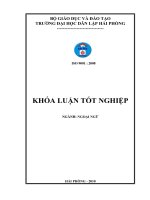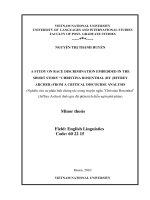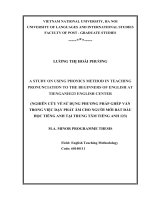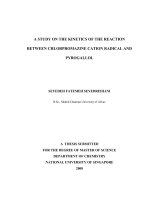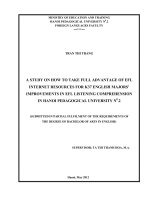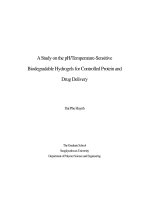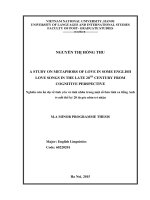A study on words from names in Nguyen Nhat Anh''s stories and their English equivalents
Bạn đang xem bản rút gọn của tài liệu. Xem và tải ngay bản đầy đủ của tài liệu tại đây (492.7 KB, 46 trang )
BỘ GIÁO DỤC VÀ ĐÀO TẠO
TRƯỜNG ĐẠI HỌC DÂN LẬP HẢI PHÒNG
-------------------------------
ISO 9001 : 2008
KHÓA LUẬN TỐT NGHIỆP
NGÀNH: NGOẠI NGỮ
HẢI PHÒNG - 2010
1
HAIPHONG PRIVATE UNIVESITY
FOREIGN LANGUAGES DEPARTMENT
-----------------------------------
GRADUATION PAPER
A STUDY ON EMOTIONAL CONNOTATION
OF CONVERSION
By:
PHAM THI MAI
Class:
NA 1004
Supervisor:
DAO THI LAN HUONG, M.A
HAI PHONG - 2010
2
BỘ GIÁO DỤC VÀ ĐÀO TẠO
TRƯỜNG ĐẠI HỌC DÂN LẬP HẢI PHÒNG
--------------------------------------
Nhiệm vụ đề tài tốt nghiệp
Sinh viên: ............................................................Mã số:..............................
Lớp: .............................Ngành:.....................................................................
Tên đề tài: ..................................................................................................
..................................................................................................
..................................................................................................
..................................................................................................
3
Nhiệm vụ đề tài
1. Nội dung và các yêu cầu cần giải quyết trong nhiệm vụ đề tài tốt
nghiệp
( về lý luận, thực tiễn, các số liệu cần tính toán và các bản vẽ).
……………………………………………………………………………..
……………………………………………………………………………..
……………………………………………………………………………..
……………………………………………………………………………..
……………………………………………………………………………..
……………………………………………………………………………..
……………………………………………………………………………..
……………………………………………………………………………..
2. Các số liệu cần thiết để thiết kế, tính toán.
……………………………………………………………………………..
……………………………………………………………………………..
……………………………………………………………………………..
……………………………………………………………………………..
……………………………………………………………………………..
……………………………………………………………………………..
……………………………………………………………………………..
……………………………………………………………………………..
4
……………………………………………………………………………..
3. Địa điểm thực tập tốt nghiệp.
……………………………………………………………………………..
……………………………………………………………………………..
……………………………………………………………………………..
CÁN BỘ HƯỚNG DẪN ĐỀ TÀI
Người hướng dẫn thứ nhất:
Họ và tên:.............................................................................................
Học hàm, học vị:...................................................................................
Cơ quan công tác:.................................................................................
Nội dung hướng dẫn:............................................................................
Người hướng dẫn thứ hai:
Họ và tên:.............................................................................................
Học hàm, học vị:...................................................................................
5
Cơ quan công tác:.................................................................................
Nội dung hướng dẫn:............................................................................
Đề tài tốt nghiệp được giao ngày 12 tháng 04 năm 2010
Yêu cầu phải hoàn thành xong trước ngày 10 tháng 07 năm 2010
Đã nhận nhiệm vụ ĐTTN
Đã giao nhiệm vụ ĐTTN
Người hướng dẫn
Sinh viên
Hải Phòng, ngày tháng năm 2010
HIỆU TRƯỞNG
GS.TS.NGƯT Trần Hữu Nghị
PHẦN NHẬN XÉT TÓM TẮT CỦA CÁN BỘ HƯỚNG DẪN
1. Tinh thần thái độ của sinh viên trong quá trình làm đề tài tốt
nghiệp:
6
……………………………………………………………………………..
……………………………………………………………………………..
……………………………………………………………………………..
……………………………………………………………………………..
……………………………………………………………………………..
……………………………………………………………………………..
……………………………………………………………………………..
……………………………………………………………………………..
2. Đánh giá chất lượng của khóa luận (so với nội dung yêu cầu đã đề ra
trong nhiệm vụ Đ.T. T.N trên các mặt lý luận, thực tiễn, tính toán số
liệu…):
……………………………………………………………………………..
……………………………………………………………………………..
……………………………………………………………………………..
……………………………………………………………………………..
……………………………………………………………………………..
……………………………………………………………………………..
……………………………………………………………………………..
……………………………………………………………………………..
……………………………………………………………………………..
3. Cho điểm của cán bộ hướng dẫn (ghi bằng cả số và chữ):
……………………………………………………………………………..
……………………………………………………………………………..
7
……………………………………………………………………………..
Hải Phòng, ngày ….. tháng ..… năm 2010
Cán bộ hướng dẫn
(họ tên và chữ ký)
NHẬN XÉT ĐÁNH GIÁ
CỦA NGƯỜI CHẤM PHẢN BIỆN ĐỀ TÀI TỐT NGHIỆP
1. Đánh giá chất lượng đề tài tốt nghiệp về các mặt thu thập và phân tích tài
liệu, số liệu ban đầu, giá trị lí luận và thực tiễn của đề tài.
8
2. Cho điểm của người chấm phản biện :
(Điểm ghi bằng số và chữ)
Ngày.......... tháng......... năm 2010
Người chấm phản biện
Acknowledgement
In order to complete this graduation paper, I have received a lot of
advices, encouragement and help from many teachers and friends.
First of all, I would like to express my deep gratitude toward my
supervisor, Mrs. Dao Thi Lan Huong – teacher of foreign language in
Haiphong Private university, who has given me valuable advice, comments
and useful suggestions. My study will be far from finished without her help.
Secondly, I also wish to express my sincere thanks to Mrs.Tran Ngoc
Lien – the dean of foreign language department of HPU for her help and
encouragements.
My thanks are also sent to all teachers in foreign language department
for their help during the time I study at the university.
I am also very grateful to my family and all my friends for their support.
Finally, I hope that this work will be useful for anyone who concern with
this theme.
Haiphong, June 2010.
Pham Thi Mai
9
TABLE OF CONTENT
Acknowledgement
PART I. INTRODUCTION ........................................................................... 1
1.Rationale of the study..................................................................................... 2
2. Aims of the study .......................................................................................... 2
3. Scope of the study ......................................................................................... 3
4. Methods of the study ..................................................................................... 3
5. Design of the study........................................................................................ 3
PART II. DEVELOPMENT .......................................................................... 4
CHAPTER I. THEORETICAL BACKOUND ............................................ 5
I. Conversion ..................................................................................................... 5
I.1.Definitions of conversion.......................................................................... 5
I.2. Characteristic features of conversion....................................................... 7
I.3. Phenomena of conversion ........................................................................ 9
I.3.1. Noun – verb ..................................................................................... 10
I.3.2. Adjective – verb ............................................................................... 11
I.3.3. Verb – noun ..................................................................................... 12
I.3.4. Noun – adjective .............................................................................. 14
I.3.5. Adjective – noun .............................................................................. 14
I.3.6. Particle – verb .................................................................................. 15
I.3.7. Modal verb – ordinary verb ............................................................. 15
I.3.8. Minor categories of conversion ....................................................... 16
I.3.9. Change of secondary word-class : nouns ........................................ 17
I.3.10. Change of secondary word-class: verbs ........................................ 18
I.3.11. Change of secondary word-class: adjectives ................................. 18
I.3.12. Approximate conversion: voicing and stress shift: ....................... 19
I.4. Classification of conversion .................................................................. 22
I.4.1. Traditional and occasional conversion ........................................... 22
I.4.2. Partial
conversion............................................................................22
I.4.3. Substantivation................................................................................ 23
10
CHAPTER II. THE EMOTIONAL CONNOTATION OF CONVERSION
IN ENGLISH .................................................................................................. 25
II.1. Neutral .................................................................................................. 26
II.2. Positive ................................................................................................. 28
II. 3. Negative ............................................................................................... 29
CHAPTER III. SOME DIFFICULTIES IN APPLYING CONVERSION
AND SUGGESTED SOLUTIONS .............................................................. 32
III.1. Some difficulties ................................................................................. 32
III.1.1. Restriction of conversion .............................................................. 32
II.1.2. Student‟s competence ..................................................................... 34
III.2. Suggested solution .............................................................................. 35
III.2.1. Watching original English films and stories, establishing English
clubs................................................................................................................. 35
II.2.2. Improving awareness of students ................................................... 35
PART III. CONCLUSION ........................................................................... 38
I. Summary ...................................................................................................... 39
II. Suggestions for further study ..................................................................... 39
REFERENCES .............................................................................................. 41
11
PART I
INTRODUCTION
12
1.Rationale of the study
Nowadays, English plays an important role in the society and become an
international language. It is widely used in the world in all aspects : trade,
economy, science and technology… Moreover, English is a requirement when
seeking jobs and often the language which much of business of good job is
conducted. In recent years, with the “open-door” policy , English learning in
our country develops strongly as a trend. It is taught not only in universities,
high schools but also in primary schools and becomes a compelled subject at
different schools.
At HaiPhong private university as well as other universities, English is a
compulsory subject and always has high complement. Every year , there are
more than 100 graduates to meet the demand of society. All those students
always try to learn English. They take advantages to practice English. They
applied what they learn in daily conversations, especially conversion is
frequently used. But conversion has different emotional connotations. When
do you use neutral , negative and positive conversion? That is a difficult
question which I want to find out the best answer. That is the reason why I
choose the research entitled “ A study on the emotional connotation of
conversion”.
2. Aims of the study
As I mention above, conversion has different emotional connotations. I
would like to investigate them and I hope that my study will help learners
deeply understand emotional connotation of conversion and have a plentiful
word resource. Therefore, the purposes of my study are :
- To introduce the general knowledge of conversion
- To study three emotional connotations of conversion
- To point out some implications of my study.
3. Scope of the study
Conversion is an important phenomenon in word formation in English
lexicology. There are many different aspects. But due to frame of time,
knowledge and experience I only focus on emotional connotation of
conversion which are neutral, negative and positive. Hopefully, learners will
find it effective and useful.
4. Methods of the study
In order to carry out this study, the theoretical background is formed on
13
the knowledge which has been gained through 4years in Haiphong private
university.
I searched information and documents in Internet, reference books and in
different libraries…
I also have discussion with my supervisor and my friends. With such
methods, I hope that this study will become successful.
5. Design of the study
With the purpose of helping learners get main ideas clearly, my study is
divided into three parts:
Part one is INTRODUCTION consists of the rationale, aim, scope,
method and design of the study.
Part two is DEVELOPMENT consists of three chapters:
Chapter I: Theoretical background, deals with the definition,
classification, characteristic features and phenomena of conversion.
Chapter II: The analysis on emotional connotation of conversion in
English. They are neutral, positive and negative connotation.
Chapter III: Some difficulties in applying conversion and suggested
solutions.
Part three is CONCLUSION, which restates the knowledge mentioned
through three chapters above. A suggestion for further study on emotional
connotation of conversion is also provided in this part.
14
PART II
DEVELOPMENT
15
CHAPTER I
THEORETICAL BACKOUND
I. Conversion
I.1.Definitions of conversion
“ Conversion is the formation of a new word in a different part of speech
without adding any element “.
(Hoang Tat Truong – Basic English Lexicology, 1993:43)
“ Conversion is the derivation process whereby an item changes its
word-class without the addition of an affix “.
For example :
The word “release” in:
They released him. (verb)
They ordered his release. (noun)
The verb “release” corresponds to a noun “release” and this relationship
may be seen as parallel to that between the verb „acquit” and the noun
“acquital”.
(Randolph Quirk and Sidney Greenbaum, 1976:441)
Yellow
To Yellow
“When a word which has hitherto functioned as a member of one class
undergoes a shift which enables it to function as a member of another we ave
what is traditionally called conversion “.
(Doan Minh, 1993:15)
Eg: party (noun) -> party (verb)
We will be at the party.
They like to party.
Must (verb) -> must (noun)
You must eat your soup.
It is a must that you call him.
Often a word of one lexical category (part of speech) is converted to a
word of another lexical category, for example, the noun “green in golf”
(referring to a putting-green) is derived ultimately from the adjective green.
16
Conversion from adjectives to nouns and vice versa are both very common
and unnotable in English, much more remarked upon is verbing, the creation
of a verb by converting a noun or other word (eg: the adjective “clean”
becomes the verb “to clean”).
According to Howard Jackson (2000:74), conversion maybe defined as a
process by which a word belonging to one word class is transferred to another
word class without any commitant change of form, either in pronunciation or
spelling.
Conversion is a highly prolific source for the production of new words,
since there is no restriction on the form that can undergo conversion in
English. In fact, this word formation process occurs so regularly that many
scholars prefer to consider it a matter of syntactic usage rather than a word
formation.
In linguistics, conversion, also called “function change” or “zero
derivation”, is a kind of word formation , especially, it is the creation of a
word from an existing word without any change in form. Conversion is more
productive in some languages than in others. In English, it is a fairly
productive process.
Conversion is the formation of new words by another class. This is a
method of turning words of one part of speech to those of a different part of
speech. These words are new only in a grammatical sense. Since the words do
not change in morphological structure but in function, its process is also
known as functional shift. The boundary between conversion and functional
shift (the extension of an existing word to take on a new syntactic function) is
not well-defined.
Conversion is probably the most popular and most defend view
nowadays. However, numerous followers maybe found from the nineteenth
century up to the present day. Among others, Sweet (1898) and Kennedy
(1935) maybe mentioned as its most important supporters.
Sweet (1898:38) seems to have been the first to use the term conversion.
He defines it as the phenomenon that makes a word into “another part of
speech without any modification or addition, except the necessary change of
inflection, etc”. Thus, the verb walk in he walks, for example, maybe said to
have been converted into a noun by simply giving it the same formal
characteristics as other nouns, as in He tools a walk, or three different walks
of life. In Sweet‟s opinion, “the” essential characteristic of conversion is the
change of lexical category, or “part of speech”. Therefore, Sweet speaks of
conversion only in those cases in which the word adopts all the formal
characteristics (inflection, for example) of the new part of speech into which
17
it have been converted. Simon (1955:307) also makes a similar point: “That
new words are ready created here and that they are not just cases of one part
of speech being used in the function of another…is testified by the fact that
these new denominal verbs fully acquire all the grammatical categories”
belonging to the new part of speech the word has been made into. In spite of
this, Sweet admits that formal criterion is not always conclusive. Accordingly,
in example like the good are happy he speaks of partial conversion, since
good, like nouns, can have a definite article before it but like adjective, it does
not take plural inflection.
Unlike Sweet (1898), who mentions the change of class as well as the
required formal changes as the conditions for the recognition of conversion,
Kennedy claims that there is no change in the form of a word but not only in
its general functions. However, he adds that conversion may only be
considered complete “when a word has changed its function to such an extend
that it is capable of taking on a new inflectional endings” (Kennedy,
1935:318).
I.2. Characteristic features of conversion.
The new words formed by conversion are different from the old words
morphologically, syntactically and semantically. In other word, the difference
between the words in each pair is morphological, syntactic and semantic.
(Basic English Lexicology – Hoang Tat Truong, 1993:43)
- Morphological: the verb “to hand”, for example, has a new paradigm
(the system of forms) : hand – handed – handing.
- Syntactic: the function of “to hand” is new, it is predicate: “he handed
me the watch”.
- Semantic: the verb “to hand” has a completely new meaning: to give,
to pass something to…, but “hand” is part of the body.
Conversion maybe said to be the most productive in forming verbs: arm
– to arm ; elbow – to elbow ; foot to foot ; skin – to skin ; bottle – to bottle ;
honeymoon – to honeymoon.
Conversion may involve a change within the same word class as in the
change from one type of noun to another or one type of verb to another. For
example, we use uncountable nouns as countable and vice versa. Thus, in
“some beer /coffee /sugar /tea”, the nouns are uncountable. Whereas in “two
beers /coffees /sugars /teas”, the nouns are countable. As a general rule, if the
context is carefully chosen, it is possible to use almost any noun in their way.
18
Even proper names can be easily used as common nouns as in “Which Hilary
do you mean? ”. Similarly, intransitive verbs are often used as transitive verbs.
For instance, we compare the components of the following pair:
Eg: How long can a pigeon fly non-stop?
Can this little boy fly a kite?
(Howard Jackson, 2000:74)
The first is intransitive and the second is transitive.
It should be noted that even a whole phrase may undergo conversion and
act as a Noun , eg: A forget-me-not, a has been, a don’t know. It may also act
as an adjective as in : A Monday morning feeling, a not-to-be-missed
opportunity.
The reason for such a wide-spread development of conversion in English
is that there are not enough affixes, especially verb-forming affixes.
(Basic English Lexicology – Hoang Tat Truong, 1993:43)
Conversion is a totally free process and any lexeme can undergo
conversion into any of the open form classes as the need arises (Bauer,
1983:226). This means that any word form can be shifted to any word class,
especially to open classes - noun, verbs, etc. and that there are not
morphological restriction. Up to date, there has only been found one
restriction: derived nouns rarely undergo conversion (particularly not to verbs)
(Bauer, 1983:226). This exception is easily understood: if there already exists
one word in the language, the creation of a new term for this same concept
will be blocked for the economy of language. For example, the noun “denial”
will never shift into a verb because this word already derives from the verb
“deny”. In that case, the conversion is the blocked because “to deny” and “to
denial” would mean exactly the same. However, there are some special cases
in which this process seems to happen without blocking. This can be
exemplified in the noun “sign”, converted into the verb to sign, changed by
derivation (suffixation) into the noun “signal” and converted into a new verb
“to signal”. In this case, there is no blocking because these words have slight
semantic differences (Bauer, 1983:226-227).
It must be pointed out that the process of conversion has some semantic
limitations: a converted word only assumes one of the range of meanings of
the original word. For example, the noun “proper” has various meaning, such
as “newspaper”, “material to wrap things”, etc. The denominal verb, though,
only contains the sense of putting that material on places likes walls. This
shows the converted item has only a converted part of the semantic field of
the source item.
Conversion is sometimes referred to as an affix less way of word19
building or even affix less derivation. Conversion helps make a new word
from some existing words.
I.3. Phenomena of conversion
Look at the word “round” in the following sentences:
Eg1: He was knocked out in the first round.
(noun)
Eg2: Round the number off to the nearest tenth.
(verb)
Eg3: The neighbors gathered round our house.
(preposition)
Eg4: The moon was bright and round.
(adjective)
Eg5: People came from all the country round.
(adverb)
In each sentence, “round” is used as a different part of speech: noun,
verb, preposition, adjective and adverb. Conversion is generally considered to
be a derivational process whereby an item is adapted or converted to a new
word class without the addition of an affix. Hence, namely zero-derivation. Take
“single” and “simple”, for example. Both are adjectives, but single can be used
as a verb without changing the form, eg: “The singled him out at once as a
possible victim”. In contrast, simple can not function as a verb without adding an
affix, eg: “continental quilts simplify (not simple) bed-making”. The first
instance is a case of zero-derivation or conversion whereas the second is one of
suffixation as the suffixify is added to make simply a verb.
Words produced by conversion are primarily nouns, adjectives and verbs.
The most productive, however, is the conversion that takes place between
nouns and verbs. It deserves noting that conversion is not only a change of
grammatical function of the lexical item involved but also is the change of
meaning.
I.3.1. Noun – verb
Verbs converted from nouns are semantically related to the original
nouns in a variety of ways.
Quirk et al sum up as follows:
(1) To put st in /on N:
Eg: To pocket the money – to put money into the pocket
To can the fruit – to put the fruit into cans.
And some more words: bottle, garage, corner, shelve, etc.
(2) To give N /to provide with N:
Eg: To oil the machine – to provide the machine with oil.
To shelter the refugees – to give shelter to the refugees.
And some more words: butter, coat, mask, arm, etc.
(3) To remove N from (to deprive of N)
20
Eg: To skin the lamb – to remove the skin from the lamb
To juice the oranges – to remove the juice from the oranges
And some more words: core, peel, feather, etc.
(4) To do with N as instrument
Eg: To pump water – to bring water with a pump
To knife the steak – to cut the steak with a knife
And some more words: rake, finger, hammer, shoulder, etc.
(5) To be /act as N with respect to …
Eg: To nurse the baby – to be the nurse for the baby
To captain the team – to act as the captain for the team for the team
And some more words: father, pilot, referee, tutor, etc.
(6) To make /change … into N
Eg: To cash the cheque – to change the cheque into cash
To orphan the boy – to make the boy an orphan
And some more words: fool, knight, cripple, etc.
(7) To send /go by N
Eg: To mail the letter – to send the letter by mail
To bicycle – to go by bicycle
And some more words: helicopter, ship, motor, telegraph, etc.
I.3.2. Adjective – verb
Conversion of adjectives into verbs is not as productive as those nouns.
The verbs thus converted are semantically simple, that is, they can be used
either transitively to mean “to make … adjective” or intransitively “to become
adjective”.
(1) Make (more) adjective (transitive verbs)
(= He walked carefully so as not to make his shoes wet)
Eg: He walked carefully so as not to wet his shoes.
Some more words: dirty, calm, slim, etc.
(2) To become adjective (intransitive verbs)
(= The photograph with age become yellow)
Eg: The photograph yellowed with age.
Some more words: dry, empty, etc.
Sometimes a phrasal verb is derived from an adjective by the addition of
a particle: calm down (to become calm).
(3) To make oneself better
21
Eg: better oneself
Since they became friends, he has tried hand to better himself.
I.3.3. Verb – noun
Almost all mono-morphemic verbs can be used as nouns, which are
semantically related to the original verbs in various ways according to Quirk
et al:
(1) State (from stative verbs to nouns)
Doubt : the state of doubting
Want : what is wanted
Some more words: desire, love, hate, smell, taste, etc.
(2) Event or activity (from dynamic verbs)
Search : the activity of searching
Laugh : the act of laughing
Some more words: attempt, hit, release, swim, shut-down
(3) Result of the action (object of verb)
Catch : what is catch?
Find : what is found?
Some more words: buy, hand-out, answer, etc.
(4) Doer of the action (subject of verb)
Help : one who helps
Cheat : one who cheats
Some more words: bore, coach, stand-in, etc.
(5) Tools or instruments to do the action with (instrument of verb)
Cover : used to cover something
Wrap : used to wrap something
Some more words: cure, paper, etc.
(6) Manner of V-ing
Pass : where one has to pass
Walk : a place for walking
Some more words: turn, drive, divide, etc.
Many simple nouns converted form verbs can be used with “have, take,
make, give, etc.” to form phrases to replace the verbs or denote a brief action:
have a look (smoke, swim, try, wash), take a walk (ride, glance, rest, shower),
give a cry (grant, start, laugh, shudder), make a move (guess, offer, slip,
attempt).
22
For example:
Eg: You‟d better have another think.
There‟s no come and go with her.
I dutifully recorded a 2-1 win for the guest team.
Words like “hand-out, stand-by, lay-by, teach-in, shut-down” are all
converted from phrasal verbs. Such conversion is very common in English.
The examples cited here keep their original order: hand-out from hand out,
stand-by from stand by, ect. Sometimes, when a phrasal verb is turned into a
noun, the verb and particle should be inverted, for example: “flow over to
overflow, break out o outbreak, fall down to downfall, take in to intake, etc.”
I.3.4. Noun – adjective
There are some clues, though, to make sure conversion has taken place.
In the case of adjectives coming from nouns, the hints are quiet easy: they can
be considered as cases of conversion only when they can appear in predicative
as well as in attributive form. If the domino adjective can be used attributively,
we can affirm that conversion has happened. If it can only appear
predicatively it is merely a case of partial conversion. Look at the following
example: “The deals come and go at dizzying place. Blink, and a hat stand is
sold for $15, an antique mahogany sewing stand and sewing machine for $30,
a mahogany music box for $75”. Mahogany music box can be used in an
attributive way: “the music box is mahogany”. This implies “mahogany” is a
denominal adjective. However, in the predicative phrase “antiques dealers”
in sentence “A bustling stretch of three sprawling action house in Gloucester
country is flea market central for antiques dealers from Quebec and Florida
and parts of South Carolina, North Carolina and Georgia”, we can not treat
“antiques” as an adjective because the attributive form of this expression is
ungrammatical (dealers are antique). Another way to make sure we are in
front of a case of conversion is to change a word for another similar one. For
example, in “Dutch Auction “ in sentence “Her two antique double-spool
beds cost her a total of $250 at Dutch Auction Sales”, we are sure the word
“Dutch” in an adjective because it has the specific form of adjective.
Therefore, in “South Jersey Auction” in “It is getting harder to get this
merchandise for the auction, said Mr. Babington, of South Jersey Auction”
or “Texas Auction” in “Twice a month , Ralph Parley stands at rapt attention
I the fluid semicircle of about so bidders, his mind on the single goal of
sending a shipment of antiques to Texas auction house”, we can affirm these
are cases of denominal adjectives.
I.3.5. Adjective – noun
Adjectives can also shift into nouns, though it is not very frequent. It
23
mainly happens in well-established patterns of adjective plus noun phrase.
Nominalization occurs when the noun is elided and the adjective is widely
used as a synonym of an existing set pattern. This could be the case of “a
Chinese favorite” in “From one direction comes the rich smell of frying bread,
from another fermented or smelly bean curd, a Chinese favorite”.
The adjective nature in cases of partial conversion is evident , though.
They are nouns from the point of view that they appear in the same syntactic
position. Their grammatical nature, though, is a different one. These
adjectives can still be changed to the comparative and superlative form
(adjective nature). This can be exemplified in “worst” (We have to assume the
worst) and “merrier” (We’ve got some older fans now, but the more the
merrier – everyone’s welcome). However, these adjectives can not behave as
nouns: if their number or case is changed, they will produce ungrammatical
sentences. This can be seen in the case of “more” (We’ve got some older fans
now, but the more the merrier – everyone’s welcome) in cases like “the more
we get”. If the “-s” for the plural is added to any of these items, we would get
ungrammatical sentences. The case of “cutie” (You are at the movies with the
cutie from), though, could be argued. It seems to be much used and
established within certain groups. This could have converted it into a
lexicalized example of adjective to noun.
Miscellaneous examples are “daily” (daily newspaper), “comic” (comic
actor). The adjective -> noun conversion can usually be explained in terms of
a well-established adjective + noun phrase from which the noun has been
ellipted.
I.3.6. Particle – verb
Consists of words are: to down, to out, to up, etc.
I.3.7. Modal verb – ordinary verb
Must (modal verb) – must (verb)
I.3.8. Minor categories of conversion
(1) Closed-system words to nouns:
There are two postulated major word classes the English language: open
class and closed class, namely, open-system words and close-system words.
An open class is one whose membership is in principle indefinite or unlimited,
whereas a closed class is one whose membership is fixed or limited.
New items are constantly being added to the open class, as new ideas
inventions, etc, appear. Nouns, verbs, adjectives and adverbs are open-class
items, that is, open-system words. New items are not regularly added to the
24
closed class as they are in the case of open-class items, pronouns, repositions,
conjunctions, article, etc. All are closed-system words.
For example:
Must (modal verb) – must (noun)
This book is a must for student of aerodynamics.
(2) Phrase – noun
Phrase or combinations of more than one word, may sometimes be
reduced to noun status by conversion.
Eg: Whenever I gamble, my horse is one of the also-rans.
(is one of the horse which “also ran” but was not among the winners)
(Quirk and Green Baum)
(3)
Particle – noun
in (to have an in-influence), down (to have down on SB)
(4) Phrase – adjective
Eg: an up-in-the-air feeling:
(with reference to cheerful)
I feel very up in the air
Eg: an upper-class manner:
His manner is very upper class. It is all to nothing that they wil
succeed.
Under the weather (phr.) – under-the-weather (adj.)
I.3.9. Change of secondary word-class : nouns
(1) Non-count -> count:
- A unit of N: two coffees (cups of coffee)
25
